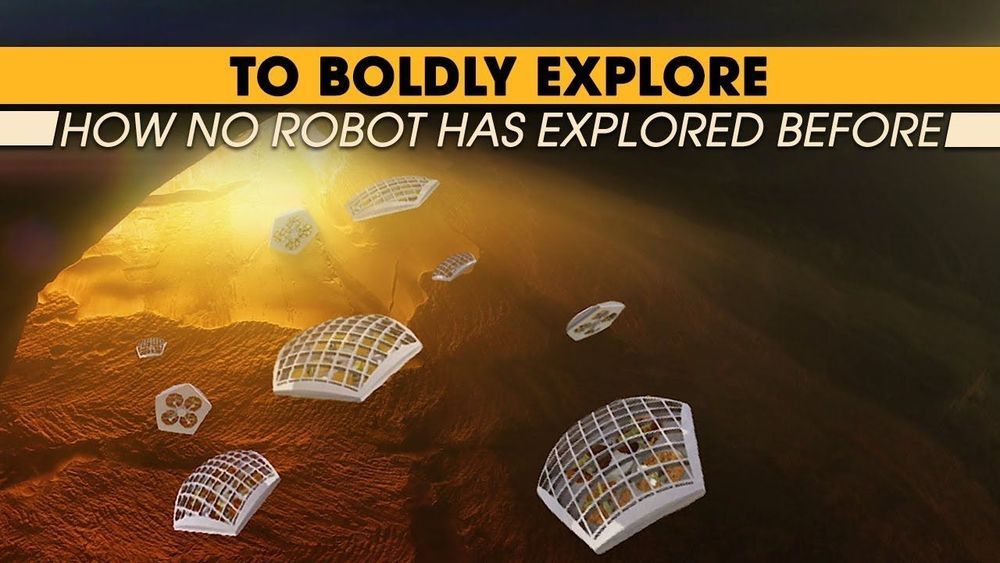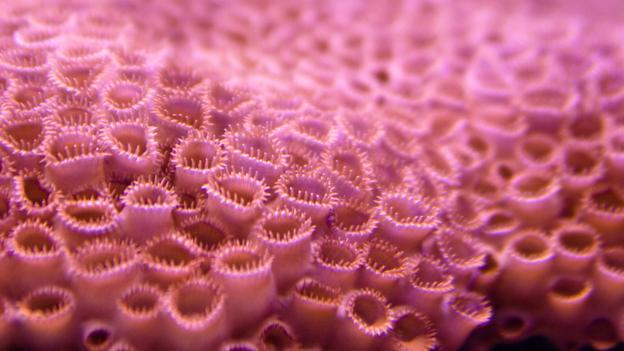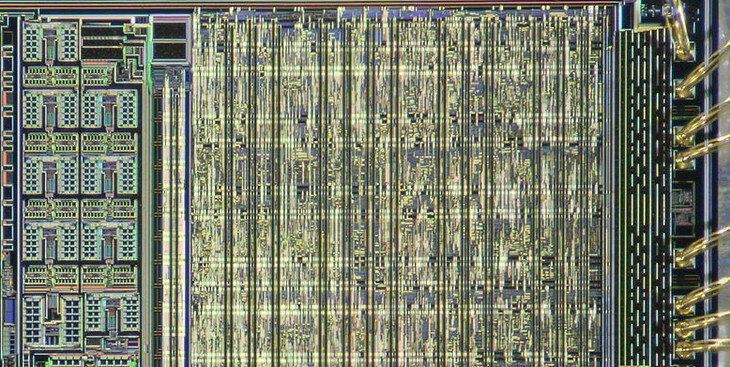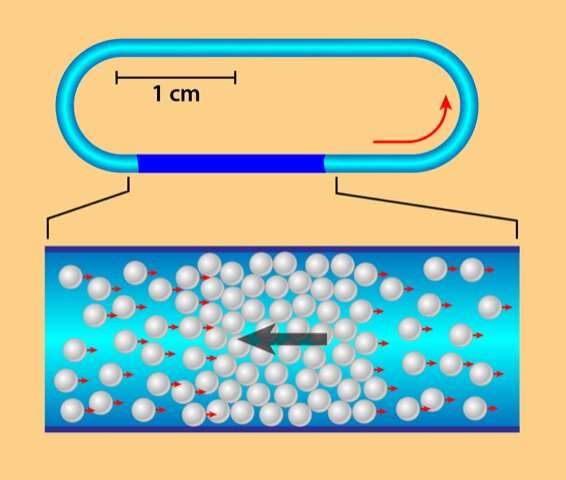As we venture onto the moons of Jupiter and Saturn to look deep below their frozen surface, might we find new forms of life there?
Page 8338
Sep 27, 2019
NASA’s rolling Shapeshifter robot concept splits into two drones
Posted by Klaus Baldauf in categories: 3D printing, alien life, drones, robotics/AI

When NASA’s Cassini performed more than 100 flybys of Saturn’s moon Titan, scientists piecing together the data began forming a picture of a pretty treacherous environment, with liquid methane rain, cold rivers and icy volcanoes all potentially part of the mix. The agency’s scientists are already at work developing vehicles that will one day be used to explore such surrounds, with its newly revealed Shapeshifter robot another interesting example.
The Shapeshifter is a developmental concept at this early stage, and is designed to change its shape depending on the type of alien terrain it encounters. The team at NASA’s Jet Propulsion Laboratory have 3D printed a prototype of the robot that is already capable of some impressive maneuvers.
Continue reading “NASA’s rolling Shapeshifter robot concept splits into two drones” »
Sep 27, 2019
DARPA aims to make networks 100 times speedier with FastNIC
Posted by Genevieve Klien in categories: internet, supercomputing
Having a slow connection is always frustrating, but just imagine how supercomputers feel. All those cores doing all kinds of processing at lightning speed, but in the end they’re all waiting on an outdated network interface to stay in sync. DARPA doesn’t like it. So DARPA wants to change it — specifically by making a new network interface a hundred times faster.
The problem is this. As DARPA estimates it, processors and memory on a computer or server can in a general sense work at a speed of roughly 1014 bits per second — that’s comfortably into the terabit region — and networking hardware like switches and fiber are capable of about the same.
“The true bottleneck for processor throughput is the network interface used to connect a machine to an external network, such as an Ethernet, therefore severely limiting a processor’s data ingest capability,” explained DARPA’s Jonathan Smith in a news post by the agency about the project. (Emphasis mine.)
Sep 27, 2019
Elon Musk Just Dropped More Tantalizing Details About SpaceX’s Starship Prototype
Posted by Genevieve Klien in categories: Elon Musk, space travel
Elon Musk is doling out more and more details about SpaceX’s next Starship prototype ahead of his big presentation this weekend.
On Saturday (Sept. 28), Musk will reveal the latest design of Starship and Super Heavy, the reusable spaceship and rocket that SpaceX is developing to take people to the moon, Mars and other distant destinations.

THE MIND, EXPLAINED takes a five-episode deep dive into how our brains handle memory, anxiety, psychedelics and dreams. Narrated by Emma Stone.
After nearly a year of labor behind the scenes, we have an announcement for you: Explained is finally back! And during this year, we’ve turned our attention to a crucial question: Why can’t we remember what is in the fridge?
Sep 27, 2019
Jumping the gap may make electronics faster
Posted by Saúl Morales Rodriguéz in categories: biotech/medical, computing, mobile phones, security, transportation
A quasi-particle that travels along the interface of a metal and dielectric material may be the solution to problems caused by shrinking electronic components, according to an international team of engineers.
“Microelectronic chips are ubiquitous today,” said Akhlesh Lakhtakia, Evan Pugh University Professor and Charles Godfrey Binder Professor of Engineering Science and Mechanics, Penn State. “Delay time for signal propagation in metal-wire interconnects, electrical loss in metals leading to temperature rise, and cross-talk between neighboring interconnects arising from miniaturization and densification limits the speed of these chips.”
These electronic components are in our smartphones, tablets, computers and security systems and they are used in hospital equipment, defense installations and our transportation infrastructure.
Sep 26, 2019
‘Lucky’ observation: Scientists watch a black hole shredding a star
Posted by Saúl Morales Rodriguéz in categories: cosmology, robotics/AI

A NASA satellite searching space for new planets gave astronomers an unexpected glimpse at a black hole ripping a star to shreds.
It is one of the most detailed looks yet at the phenomenon, called a tidal disruption event (or TDE), and the first for NASA’s Transiting Exoplanet Survey Satellite (more commonly called TESS.)
The milestone was reached with the help of a worldwide network of robotic telescopes headquartered at The Ohio State University called ASAS-SN (All-Sky Automated Survey for Supernovae). Astronomers from the Carnegie Observatories, Ohio State and others published their findings today in The Astrophysical Journal.
Sep 26, 2019
Researchers observe phase transition in artificially created flock
Posted by Saúl Morales Rodriguéz in categories: computing, particle physics, transportation
A team of researchers affiliated with several institutions in France has observed a phase transition in an artificially created flock. In their paper published in the journal Physical Review Letters, the group describes how they created their artificial flock and the events that led to a phase transition.
Scientists trying to understand crowd behavior generally create computer models meant to mimic human behavior under crowded conditions—but such simulations are limited by the parameters that are used to create them. Most in the field agree on the need to recreate crowd or flocking behavior physically in a lab. In this new effort, the researchers have built on prior work with an artificial crowd, and have found that under certain conditions it underwent a phase transition similar to water freezing to an ice state.
Working on a prior effort, some of the team members created an artificial crowd consisting of millions of beads suspended in a liquid between two plates of glass. The plates were joined in a way that allowed the beads to move around the outer edges of an oval—similar to cars on a partially three-dimensional race track. The beads were forced to move in one direction by applying an electric field—the Quincke effect spun the beads, which pushed them through the liquid in the same direction. Also, due to a dipole effect, the beads did not adhere to one another—instead, they moved around the track, seemingly of their own accord. The prior team showed that increasing density of the beads could set off a Vicsek-like transition in which randomly moving particles exhibit flock-like behaviors. In this new effort, the researchers used the same setup with the beads to create a flock and then watched what would happen as density was increased.
Sep 26, 2019
Groudbreaking study accidentally reveals biological age may be reversible
Posted by Paul Battista in categories: biotech/medical, genetics, life extension
A new study shows that scientists might be able to not only slow the process of aging but actually reverse it, Benjamin Button-style.
Volunteers in a California study were given a cocktail of three common drugs for one year— a growth hormone and two diabetes medications. Scientists had been testing the drugs in the hope of regenerating the thymus gland.
But upon further analysis, they found that participants had lost an average of 2.5 years on their “epigenetic clock,” measured by analyzing marks on a person’s genomes, according to the journal Nature. Participants’ immune systems also showed signs of rejuvenation.
Sep 26, 2019
Leonard Susskind: Quantum Mechanics, String Theory and Black Holes
Posted by Paul Battista in categories: cosmology, quantum physics, robotics/AI

https://www.youtube.com/watch?v=s78hvV3QLUE
Leonard Susskind is a professor of theoretical physics at Stanford University, and founding director of the Stanford Institute for Theoretical Physics. He is widely regarded as one of the fathers of string theory and in general as one of the greatest physicists of our time both as a researcher and an educator. This conversation is part of the Artificial Intelligence podcast.
INFO:
Podcast website:
https://lexfridman.com/ai
iTunes:
https://apple.co/2lwqZIr
Spotify:
https://spoti.fi/2nEwCF8
RSS:
https://lexfridman.com/category/ai/feed/
Full episodes playlist:
Clips playlist:
Continue reading “Leonard Susskind: Quantum Mechanics, String Theory and Black Holes” »














